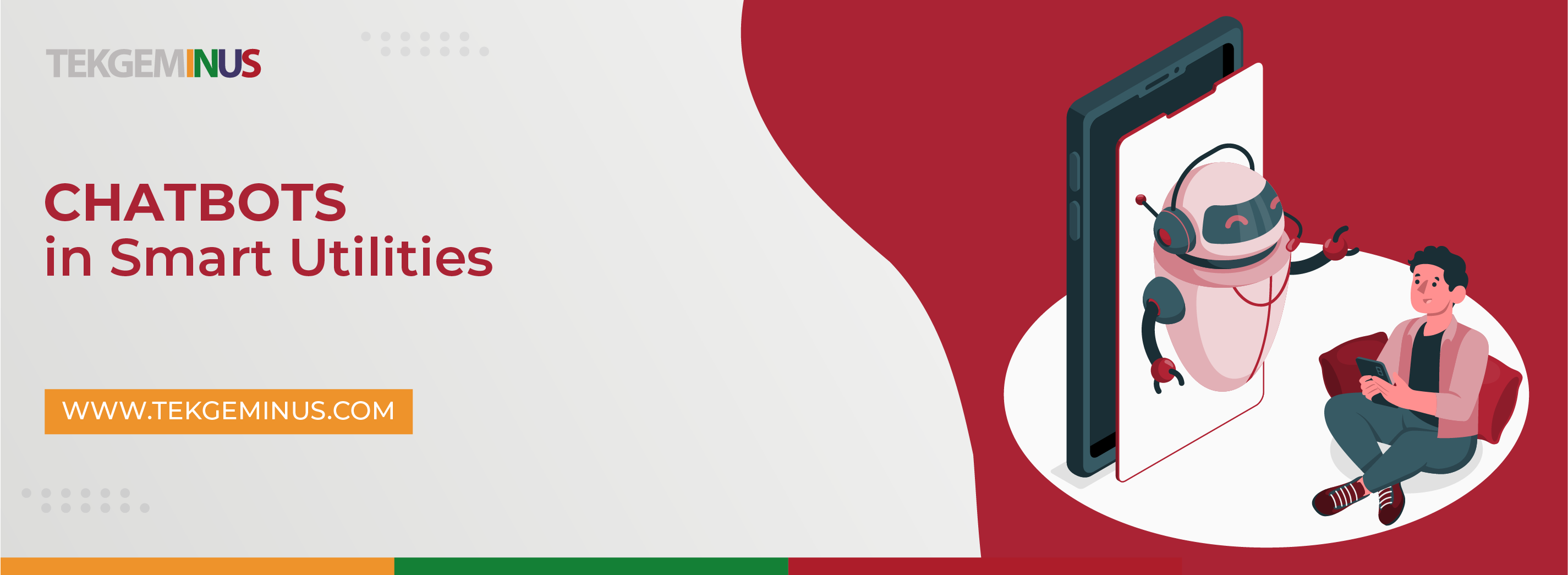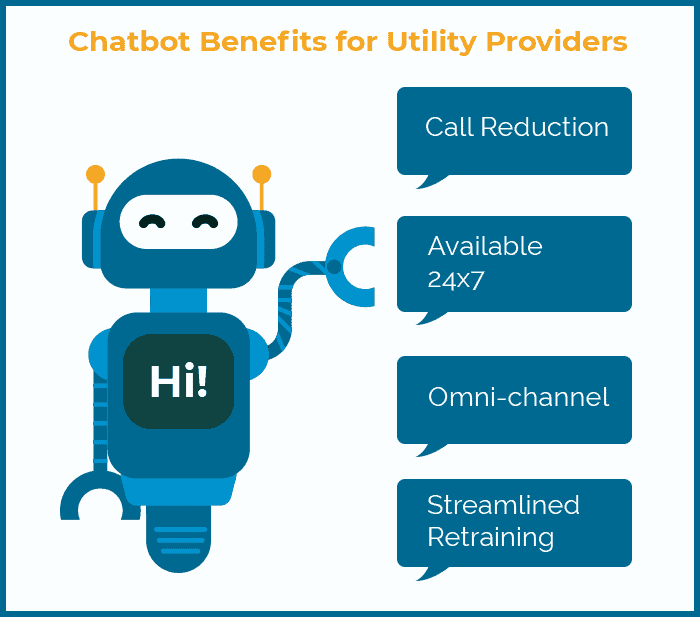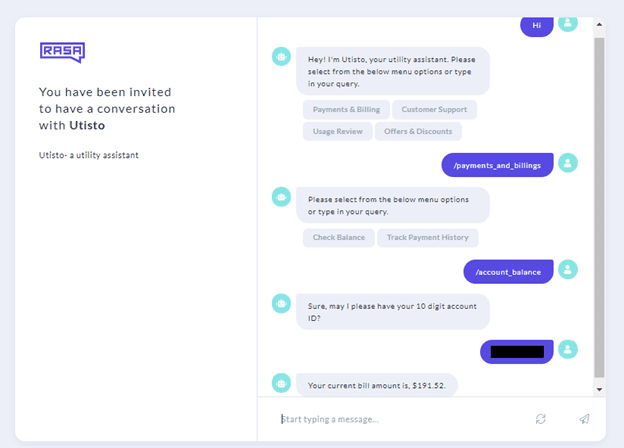We live in an era where answers must be available in an instant! Consider a scenario where a customer’s critical time is spent on interacting with different customer support agents 🙁 It elongates the timeline to close customer issues and impacts the company’s bottom line.
The energy and utilities industry is certainly not an exception! As mentioned in the evolution of smart meters blog, customer expectations have skyrocketed and additional wait time in solving queries could be a sure shot disaster for the company.

Here are some of the typical scenarios when customers reach out to Customer Service Agents (CSAs):
- Start, stop or move service
- Billing complaints
- Plans and migrations
- Alerts and program enrollments
- Report outages
- Queries related to payment history
- Auto-pay Reconnect
- Self-service portal related issues
Chatbots powered by Artificial Intelligence (AI) and Machine Learning (ML) can help utilities elevate the CX whilst reducing the overhead costs. As per reports, the chatbot market is expected to grow at a CAGR of 22.5% between 2020 and 2027.
This speaks volumes about the importance of chatbots in utilities, as the utilities domain’s NPS (Net Promoter Score) is not up to the mark. In this blog, I will deep dive into the role of chatbots in utilities by demonstrating Utisto – a Digital Assistant built on the RASA stack that enhances customer engagement for utilities.
How Chatbots Address Utility Challenges
As I mentioned earlier, low NPS is one of the biggest concerns for the overall utilities industry, and an ideal way to improve the score is by providing an exceptional customer experience. The answer to this critical question lies with chatbots.
For starters, chatbots are conversational agents that leverage the potential of Artificial Intelligence (AI) to simulate a conversation in a natural language. Before COVID-19, many utility providers relied on traditional call centers to address customer queries related to billing, Time of Day in smart meters, and more.
Fast-forward now… reliance on CSAs (Customer Service Agents) has reduced drastically, as customers expect faster resolutions for mundane requests (e.g. balance checks, payment history, etc.). Such queries can be resolved by chatbots trained for handling queries that do not require any kind of manual intervention.
As per my experience, chatbots should be used when you intend to make the best use of human intelligence (which is in solving complex tasks)! Needless to say, chatbots are available 24/7, 365 days a year 🙂 Chatbots in the E&U (Energy & Utilities) industry have the potential to improve efficiencies, achieve higher retention rates (or reduce customer churn), and enhance customer engagement.
Chatbot conversations not only improve customer service but also WoW the customers!

Benefits of Chatbots in Utilities
Now that I have touched upon how smart utility companies can leverage the benefits of chatbots, let’s reiterate some of the significant benefits of chats in utilities:
Faster Query Resolution
No one wants to spend precious time talking to different CSAs about the issues that can be resolved in a few minutes. This situation is more relevant for customer queries that can be solved without human intervention (e.g. fetching details about the current bill).
Since chatbots use AI and ML technologies, they are loaded with predefined rules (or FAQs) that can be instrumental in solving rudimentary customer queries. Think of it as a customer entering his/her personal details and requesting the chatbot about the pending billing amount! The chatbot can reply to such queries in the blink of an eye.
Overall, chatbots help in providing an amazing customer experience along with reducing call-center costs. This leads to an improvement in First Call Resolution (FCR) – a key metric to measure the efficiency of call centers (or contact centers).
Intent-driven chatbots continually learn new customer phrases, recognize context & customer intent faster; thereby providing customers with a more personalized intent-driven resolution.
Read – Big Data in Utilities
Round the clock availability
It is a known fact that humans cannot work 24/7 🙂 On the other hand, chatbots are available round the clock. Utility companies can leverage chatbots for solving customer queries where manual intelligence is not at all required.
Answers to such queries can be fetched from the back-end, thereby resulting in a quicker problem resolution. Complex customer queries (or questions) that cannot be solved by chatbots can be resolved through the normal CSA route. This hybrid approach eventually helps in reducing the burden on the CSA, resulting in significant savings on the operational front.
Leverage the potential of multi-channel approach
Just like omnichannel is gaining momentum in the e-commerce industry, the multi-channel approach is gaining traction in the utilities industry. What does this comparison even mean? Well, let me decipher it for you 🙂
A majority of the players in the e-commerce industry provide customers with various options from where they can buy (or pick up) products. This approach provides customers with a unified experience across all the different channels (e.g. online, in-store, kiosks, etc.).
On similar lines, chatbots and human agents can co-exist for resolving customer queries at a faster pace, together they have the potential to transform contact centers!
Utisto: Chatbot to enhance customer engagement
When working with utility clients, I realized that chatbots can have a significant impact on the customer experience. In fact, every utility company must leverage the benefits of conversational AI chatbots to reduce customer churn.
Having said that, let me share about Utisto – an open-source digital assistant that is built on the RASA stack that enhances customer engagement for utilities. In case you are new to RASA, do check out Getting Started Guide with RASA.
Utisto exploits popular customer-support platforms and models to build AI-powered, multi-lingual, and text & voice-controlled assistant (or chatbot).
Since TekGeminus is a pioneer when it comes to Oracle utilities outsourcing, I have ensured that Utisto can be seamlessly integrated with Oracle Utilities Application Framework (CC&B, C2M, MDM) via real-time web service calls for the utilities sector.
As mentioned in RASA’s core model, here are the major files that are a part of the model:
- data/nlu.md – Contains the intents that the assistant can recognize and set the context to the user’s query.
- data/stories.md – Contains the training stories that represent the conversations between the utility customer (or user) and the chatbot.
- domain.yml – Describes the domain of the assistant that includes intents, entities, slots, responses, and actions.
Shown below is the screenshot that indicates how Utisto responds to customer queries:

Intrigued to know more about Utisto and contribute to this chatbot (or assistant) for the betterment of the utilities industry, do feel free to contribute to the project:
Conclusion
AI and Machine Learning are reshaping many industries, utilities is no exception. When it comes to utilities, chatbots are instrumental in delivering a positive impact across the entire CX value-chain.
Chatbots in utilities help in reducing the overhead costs incurred in maintaining large CSA teams. On the whole, utility companies can take the advantage of conversational-AI chatbots to provide customers with faster resolutions – a factor that will have a significant impact on the company’s bottom-line.
Are you a Utility company looking to improve customer experience through chatbots? If so, do have a look at our technology expertise in the Utility Domain at https://www.tekgeminus.com/technology-stack/.



